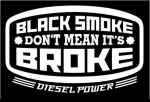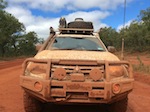Noticed a small patch of rust above my windscreen a couple of weeks ago, thought I must get it seen to. Just looked at it again and there's now a strip of missing paint around 25cm long... no idea why or how, it hasn't been damaged by anything to my knowledge.
It's a white 2017 and still 3 months of warranty left, but I'm already gearing up for a shit-fight.
Anybody else ever seen anything similar?
https://imghostr.net/image/277841882-299388239021739-902266914138159054-n.f0uGE
Paint damage white Triton???
12 posts
• Page 1 of 1
Re: Paint damage white Triton???
Geezus, just by chance has the windscreen been replaced at some stage, shivering to think what its like under the rubber, bloody silicone is bad for that as it holds water
-

WUNSIE - Posts: 405
- Joined: Sat May 28, 2016 5:40 pm
- Location: NSW Hunter Valley
Re: Paint damage white Triton???
Take back to dealer immediately and get them to take lots of photos, as should you.
This should be covered under warranty - it's a failure of the bond between topcoat and primer. And yes, I've seen it before. Toyota had a problem with Corollas and Citroen also had cars that you could wash the paint off with a hose. There have been others - it just happens sometimes.
This should be covered under warranty - it's a failure of the bond between topcoat and primer. And yes, I've seen it before. Toyota had a problem with Corollas and Citroen also had cars that you could wash the paint off with a hose. There have been others - it just happens sometimes.
Chris
If work is so terrific, why do they have to pay us to do it?
If work is so terrific, why do they have to pay us to do it?
-

NowForThe5th - Moderator
- Posts: 9240
- Joined: Sun Jun 15, 2008 2:00 pm
- Location: Holt, ACT
Re: Paint damage white Triton???
I purchased the car used, from a Mitsubishi dealer. They did replace the windscreen prior to me purchasing the car, that was 3 years ago.
- Seana
- Posts: 57
- Joined: Thu Aug 27, 2009 4:05 pm
Re: Paint damage white Triton???
Subaru had that problem too, plenty of 03 Foresters getting around with paint flaking like that... including ours, sadly. 
Sent from my SM-G970F using Tapatalk

Sent from my SM-G970F using Tapatalk
TO SEE HOW TO HAVE A TRIP OF A LIFE TIME v
http://www.exploroz.com/Members/281229. ... x#mptabs=2
http://www.flickr.com/photos/exploroz/
Only those who will risk going too far can possibly know how far they can go.
http://www.exploroz.com/Members/281229. ... x#mptabs=2
http://www.flickr.com/photos/exploroz/
Only those who will risk going too far can possibly know how far they can go.
-

srb - Platinum Subscriber
- Posts: 1737
- Joined: Sun Feb 06, 2011 6:10 pm
- Location: Sydney
Re: Paint damage white Triton???
Geez they still have this problem? My neighbours white ML seems to have more paint falling off it every time I see it, just flaking off in massive patches revealing undercoat. Mine is metallic so has the common oxidization of the clear coat. Mitsubishi just can't seem to work out how to paint cars.
- Bodgy
- Posts: 6
- Joined: Wed Feb 09, 2022 2:40 pm
Re: Paint damage white Triton???
Bodgy wrote:Geez they still have this problem? Mitsubishi just can't seem to work out how to paint cars.
Yet my wifes 2006 ASX, the paint is bloody perfect as good as the day she bought it, surely it has something to do with the plant in which they are painted in, who knows maybe the Triton paint shop is 200 mt up the road from assembly line and the vehicles pass out through the Extremely High Humidity Thailand Ambient Atmosphere and the bare or Primed metal Shell actually sweats.
My little 2001 Hilux workmate Tray back has awesome paint for its age,more so all the under body has a relativity nice thick FULL COVERAGE unlike the Triton where its so thin in some places its like overspray will do, such as inside the door Jambs,
-

WUNSIE - Posts: 405
- Joined: Sat May 28, 2016 5:40 pm
- Location: NSW Hunter Valley
Re: Paint damage white Triton???
WUNSIE wrote:surely it has something to do with the plant in which they are painted
Basically, this is it. Sometimes a contaminant can get on the body after or even while it's dipped. Not visible, no fisheyes or anything, but just hasn't stuck and only becomes apparent once it's damaged, even just a bit. A shift in humidity can be enough and Thailand is very humid.
Back in the late 1980s I had to deal with hundreds of Falcons that had a racing stripe right down the middle. Only visible in certain lighting conditions, happened because one of the spray heads in the factory at Broadmeadows had an almost microscopic dot of dried paint on the aircap. That was just after Ford spent something like $8M upgrading the paint facility.
The single coat of clear on door jambs and similar is intentional. It's all that is necessary, given that those areas are not exposed to UV like the rest of the outside. However, the thin clear coat issue on the rest of the outside is another story. That's just a way to save money. Holdens used to have a paint design life of 10 years, Thai built stuff (except Honda) is 5 years. Toyota saved over $100M USD annually a few years ago by reducing their DFTs by only 30μm. Honda did the same thing, with little effect on longevity, but kept their paint quality standard high. Unfortunately Mitsubishi went the whole hog and (IMHO) compromised on quality as well, more in Thailand than anywhere else. My Pajero, built in Japan, has almost double the paint thickness (at 130μm) of a Triton and after nearly 10 years of living outside every day shows absolutely no sign of degradation. But my snorkel, on which I tried a cheaper clear that the paint company was trying to sell me, is almost back to bare plastic. So quality matters, even if it comes at a higher cost, it's always cheaper than having to respray it.
Chris
If work is so terrific, why do they have to pay us to do it?
If work is so terrific, why do they have to pay us to do it?
-

NowForThe5th - Moderator
- Posts: 9240
- Joined: Sun Jun 15, 2008 2:00 pm
- Location: Holt, ACT
Re: Paint damage white Triton???
Thanks everybody for the replies. I was talking to a Mitsu mechanic who says he sees it a lot on white Tritons, particularly coastal cars. I have booked it in for a couple of weeks to have it assessed, no doubt it's going to be a shit-fight (a different dealer).
Showed a car detailer and his response; Shit paint job. About sums it up.
Will let you know how I make out.
Showed a car detailer and his response; Shit paint job. About sums it up.
Will let you know how I make out.
- Seana
- Posts: 57
- Joined: Thu Aug 27, 2009 4:05 pm
Re: Paint damage white Triton???
So an update for who's interested. Booked it in with the dealer for paint assessment. Took photos, a couple guys talked about it, asked me to go get two quotes and email to them. Didn't admit it was a warranty claim but that's probably standard.
Two quotes; one guy said might be related to windscreen replacement, which was done by the dealer before I got the car. Second guy said shitty paint job. Both said remove front/rear glass, full roof strip and repaint, around $2.5K.
My crystal ball says it's going to be a fight with Mr Mitsu over this one.
Two quotes; one guy said might be related to windscreen replacement, which was done by the dealer before I got the car. Second guy said shitty paint job. Both said remove front/rear glass, full roof strip and repaint, around $2.5K.
My crystal ball says it's going to be a fight with Mr Mitsu over this one.
- Seana
- Posts: 57
- Joined: Thu Aug 27, 2009 4:05 pm
Re: Paint damage white Triton???
I got my money on when they replaced the windscreen 3 years ago, thats a lot of time for any tiny nick through the topcoat to fester into something more sinister, like anything money/ warranty related no one is going to admit guilt, thanks for keeping us updated , nothing worse than hearing or being asked questions only to never hear back re; outcome 
-

WUNSIE - Posts: 405
- Joined: Sat May 28, 2016 5:40 pm
- Location: NSW Hunter Valley
Re: Paint damage white Triton???
Well it's been a long, drawn out saga, but finally a result.
The quotes came in at $2500 and $3500 and involved removing front/rear glass and stripping the whole roof and repainting.
After a few weeks I called back my local dealer; they didn't even realise they had received the quotes. They forwarded them to head office. Called back a couple weeks later, was told quotes were rejected, too expensive, they were only prepared to pay $1500. Suggested I get more quotes or negotiate with repairer directly (WTF?).
Called MMAL, explained the situation, they said they would get in contact with local dealer, which they did, and sent me reply email and gave me a contact name. Couple weeks later, no contact, so called. Was told that person no longer worked there. Great.
Contacted MMAL again, told them I'm over it, I have now made contact with Mitsubishi 11 times and all I want is my car fixed.
Received a call from dealer this morning, they have now accepted the cheaper of the two quotes and car is being booked in for paint correction. So a three month ordeal and no end of frustration, but finally a result!
The quotes came in at $2500 and $3500 and involved removing front/rear glass and stripping the whole roof and repainting.
After a few weeks I called back my local dealer; they didn't even realise they had received the quotes. They forwarded them to head office. Called back a couple weeks later, was told quotes were rejected, too expensive, they were only prepared to pay $1500. Suggested I get more quotes or negotiate with repairer directly (WTF?).
Called MMAL, explained the situation, they said they would get in contact with local dealer, which they did, and sent me reply email and gave me a contact name. Couple weeks later, no contact, so called. Was told that person no longer worked there. Great.
Contacted MMAL again, told them I'm over it, I have now made contact with Mitsubishi 11 times and all I want is my car fixed.
Received a call from dealer this morning, they have now accepted the cheaper of the two quotes and car is being booked in for paint correction. So a three month ordeal and no end of frustration, but finally a result!
- Seana
- Posts: 57
- Joined: Thu Aug 27, 2009 4:05 pm
12 posts
• Page 1 of 1
Who is online
Users browsing this forum: No registered users and 0 guests

